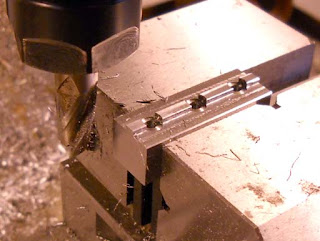
My lathe is powered by a 1/4HP 220 volt 3 phase motor with a jack shaft attached to the motor

The motor is controlled by a VFD (variable frequency drive), which gives me speed control from zero to max, forward and reverse, controlled start and stop, and a number of other features which I have as yet not found a use for.

Why the need for a jack shaft?? At very low RPM, the motor also produces very low torque. With the reduction in speed, and conversely the increase in torque I get with the jack shaft,(a factor of approx 2.5), I can get a spindle speed of approximately 50 RPM and still get plenty of torque (the belts will slip before the motor will stall)

This method of mounting the dial indicator allows the use of the carriage stop.

The tailstock has the usual modifications, the lever extension is simply a 5 inch piece of 1/2 inch copper pipe with a brass knob locktited at the tip. A tommy bar replaces the hex screw.

Simple tip: Sliding a 7/8 inch ID O-ring over the carriage hand wheel, provides the friction required to prevent the hand wheel from "creeping" out of adjustment.

My motor mount is made of 2 inch angle iron and 1/4 inch slide rods mounted on a wood base.

A front view shows the belt tensioning screw.
























